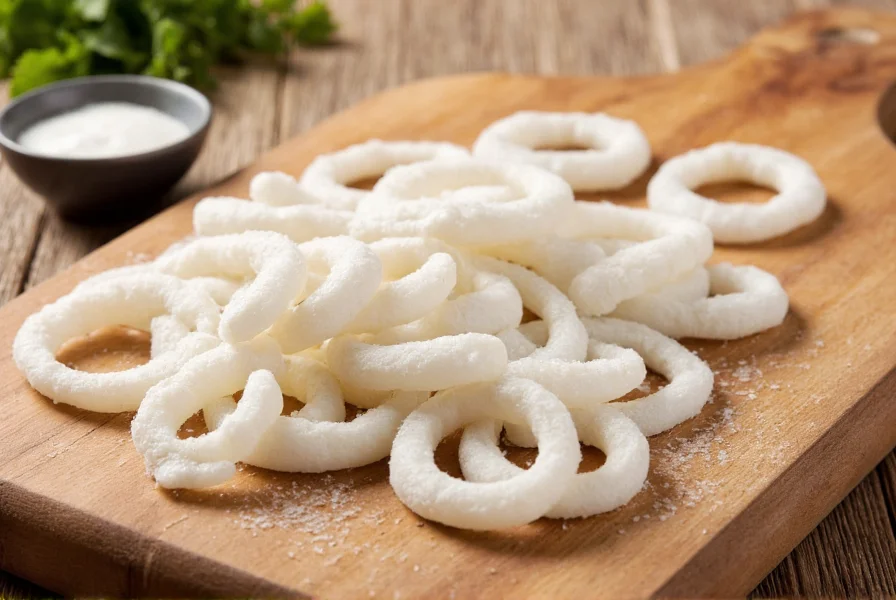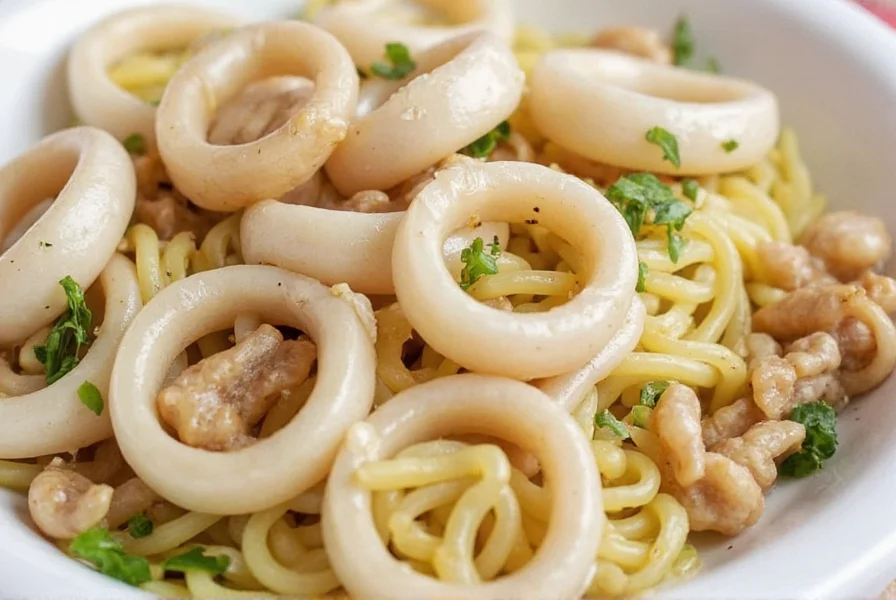Craving that irresistible crunch and aromatic spice of restaurant-style salt & pepper squid? This authentic recipe delivers the perfect balance of crispy texture and bold flavors you'd expect from a top Chinese seafood restaurant—all achievable in your home kitchen. The secret lies in precise temperature control and using fresh ingredients rather than pre-ground spices.
Why This Salt & Pepper Squid Recipe Works
Unlike many online recipes that produce soggy or rubbery results, this method focuses on three critical elements: proper squid preparation, optimal oil temperature, and precise cooking time. Fresh squid contains significant moisture, so effective drying and a light cornstarch coating create that signature crispness without heavy batter. The double-frying technique—first at 325°F (163°C) to set the coating, then at 375°F (190°C) for maximum crispness—makes all the difference between good and exceptional results.
Essential Ingredients for Authentic Flavor
The magic of salt & pepper squid comes from surprisingly few ingredients, but each plays a crucial role. Don't substitute pre-ground pepper—freshly cracked gives superior aroma and heat distribution. Here's what you'll need for 2 servings:
| Ingredient | Quantity | Key Purpose |
|---|---|---|
| Fresh squid (cleaned) | 1 lb (450g) | Base protein—must be fresh, not frozen |
| Cornstarch | 1/2 cup | Creates light, crispy coating |
| Fresh black peppercorns | 1 1/2 tbsp | Essential for authentic aroma and heat |
| Garlic cloves | 4 large | Provides foundational savory note |
| Fresh red chili | 1-2 | Adds subtle heat without overwhelming |
| Sea salt | 1 tsp | Enhances all flavors without metallic taste |
Step-by-Step Preparation Guide
Follow these detailed instructions for perfect salt & pepper squid every time. The entire process takes about 30 minutes from start to finish.
Preparing the Squid
Carefully clean fresh squid by removing the quill, innards, and skin if desired (though many chefs leave the skin on for color). Rinse thoroughly under cold water, then pat completely dry with paper towels—this step is critical for crispiness. Cut into 1-inch rings, making sure pieces are uniform for even cooking. Place in a bowl with 1 teaspoon salt and let sit for 10 minutes to draw out excess moisture, then drain and pat dry again.
Coating Technique
In a large ziplock bag, combine 1/2 cup cornstarch with 1/2 teaspoon five-spice powder (optional but traditional) and 1/4 teaspoon white pepper. Add dried squid rings in batches, seal the bag, and shake gently to create an even, light coating. Shake off excess—too much coating creates a heavy batter. Let rest for 5 minutes while you prepare other ingredients.

Frying Process
Heat vegetable oil in a wok or deep skillet to 325°F (163°C). Fry squid in small batches for 45 seconds until just beginning to turn opaque. Remove with a slotted spoon and drain on wire rack. Increase oil temperature to 375°F (190°C) and refry for 20-30 seconds until golden and crisp. This double-fry method ensures maximum crispness while preventing overcooking.
Creating the Signature Flavor
Drain all but 1 tablespoon oil from wok. Add 4 thinly sliced garlic cloves and 1-2 sliced fresh red chilies. Stir-fry over medium heat for 30 seconds until garlic turns golden. Immediately add the freshly fried squid, 1 1/2 tablespoons freshly cracked black pepper, and 1 teaspoon sea salt. Toss vigorously for 20-30 seconds until evenly coated. The pepper should become fragrant but not burnt.

Pro Tips for Perfect Results
- Oil temperature is critical—use a thermometer; too cool makes squid greasy, too hot burns the coating
- Never overcrowd the wok—fry in small batches to maintain oil temperature
- Use fresh squid—frozen squid releases too much water and becomes rubbery
- Crack pepper just before cooking—pre-ground pepper loses volatile oils essential for authentic flavor
- Serve immediately—squid loses crispness quickly as it sits
Common Mistakes to Avoid
Many home cooks struggle with salt & pepper squid because of these preventable errors. First, using frozen squid guarantees poor texture—thawed squid releases too much moisture during cooking. Second, skipping the double-fry technique results in either undercooked coating or overcooked squid. Third, adding pepper too early causes it to burn and become bitter. Finally, using pre-ground pepper creates a flat, one-dimensional flavor profile compared to freshly cracked.
Serving Suggestions
Salt & pepper squid shines as an appetizer but also works well as part of a larger meal. Serve immediately with:
- Lemon wedges for a bright acidic contrast
- Steamed jasmine rice to balance the spice
- Crisp Asian-style slaw for texture contrast
- Light lager or crisp white wine to cut through the richness
Variations to Try
Once you've mastered the classic version, experiment with these authentic variations:
- Spicy version: Add 1/2 teaspoon Sichuan peppercorns with the black pepper
- Chef's special: Include 2 thinly sliced scallions during the final toss
- Vegetarian alternative: Substitute king oyster mushrooms for squid
- Crispy garlic version: Double the garlic and fry until deep golden before adding squid
Storage and Reheating Guidelines
Salt & pepper squid is best enjoyed immediately, but if you must store leftovers, place in an airtight container with paper towels to absorb moisture. Refrigerate for up to 24 hours. To restore crispness, reheat in an air fryer at 350°F (175°C) for 3-4 minutes—never use a microwave, which creates rubbery texture. The double-fry method helps maintain quality during reheating, but texture will never match freshly prepared.
Frequently Asked Questions
Can I use frozen squid for salt and pepper squid recipe?
While possible, frozen squid releases excess moisture during cooking, resulting in less crispy texture and potentially rubbery consistency. Fresh squid yields significantly better results. If using frozen, thaw completely in the refrigerator and pat extremely dry before proceeding.
Why does my salt and pepper squid turn out rubbery?
Rubbery texture typically comes from overcooking or using frozen squid. Squid cooks extremely quickly—60-90 seconds total in hot oil. Frozen squid also releases water during cooking, causing the coating to absorb moisture and become soggy. Ensure oil is at proper temperature (350°F/175°C) and use fresh squid for best results.
What's the difference between salt and pepper squid and calamari?
Traditional calamari typically features a light batter and is served with marinara sauce, while salt and pepper squid uses a minimal cornstarch coating and features bold seasoning with fresh pepper and salt. The Chinese preparation emphasizes wok hei (breath of the wok) with garlic and chili, creating a completely different flavor profile and texture experience.
How can I make salt and pepper squid less spicy?
Reduce or omit the fresh red chili while maintaining the black pepper. You can also remove chili seeds before slicing. For milder heat, use half a chili instead of one or two. Remember that the black pepper provides essential flavor even in non-spicy versions—don't eliminate it completely.
Can I bake salt and pepper squid instead of frying?
While possible, baking won't achieve the same crisp texture as proper double-frying. For best results, use an air fryer at 400°F (200°C) for 8-10 minutes, spraying lightly with oil. The texture will be different—more roasted than crispy—but still flavorful. Traditional preparation requires frying to achieve authentic restaurant-quality results.











 浙公网安备
33010002000092号
浙公网安备
33010002000092号 浙B2-20120091-4
浙B2-20120091-4